Recommended accommodation
Xikou Huijin Hotel ¥ 110, book now >
Launch more hotels
Published on July 16, 2014 20:53
On November 2, I arrived at Xikou last night and stayed at Huijin Hotel on Baizhang road. There was a light rain in the morning. Three people went out with umbrellas and had breakfast at Wuling Road near the hotel: soybean milk, fried dough sticks, glutinous rice balls, fried eggs and rice porridge. The total cost was 24 yuan. After dinner, I bought oranges at the roadside stall for 11 yuan. Today's plan is to visit Chiang's hometown in the morning, Xuedou mountain in the afternoon, and then drive directly to Haining.
At Wuling intersection, there is the "Wuling ticket office" of China Travel Agency. Tickets for various scenic spots in Xikou can be bought separately or in combination according to different combinations. We knew little about Xikou in advance, except that there was a "hometown of Chiang" and a "Xuedou Temple". In the face of these various ways of ticket sales, I really feel a little confused. Three people are weighing, a seemingly extremely enthusiastic tricycle driver came up to show us where we can see, where we don't need to see, let us not only feel grateful for him, but also listen to some confused. Finally, the tricycle driver showed his "trump card". It turned out that he wanted to pull us to "Chiang's hometown". A car can take three people, the charge is only 10 yuan, we think it is not expensive, so we got on the car. After seeing a "tour map of Jiang's former residence scenic spot", I found that in fact, "Wuling ticket office" and "Jiang's former residence" are only very close, walking into a nearby "Wuling gate", there is no need to take a bus at all.
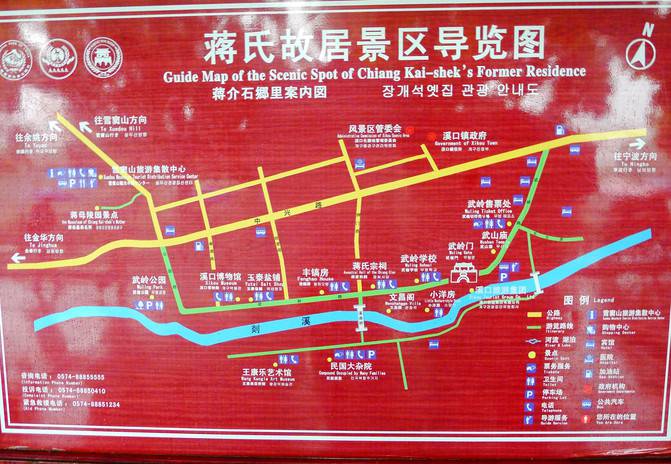
The tricycle went a long way, crossed a bridge, and arrived at "Chiang's hometown (Republic of China courtyard)" at 9:00. The sign in front of the door shows that this is the "Zhejiang intangible cultural heritage tourist attraction" recognized by Zhejiang Provincial Department of culture and Tourism Administration. The ticket is 50 yuan per person, half price for people over 70 years old. We buy one half ticket and two full tickets, which cost 125 yuan in total. However, after walking in, I realized that this is actually a newly built exhibition hall, which has nothing to do with Chiang Kai Shek's former residence. The real "Chiang Kai Shek's former residence" is located on the other side of the river (Shanxi) in front of the exhibition hall. However, there are abundant pictures and materials in this exhibition hall, detailing Chiang Kai Shek's life. One and the only one dedicated to Jiang Jieshi is a unique Pavilion on the Chinese mainland.
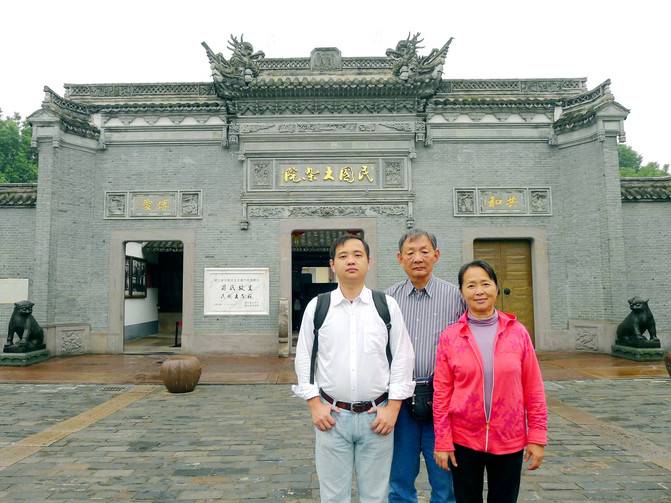
Xikou is the hometown of Chiang Kai Shek. The local people "like him more than they hate him". The announcer girls call him "Chiang Kai Shek" repeatedly. The bronze statue of "commander-in-chief Jiang" on horseback at the entrance of the exhibition hall is also completely shaped according to the hero. A few years ago, when visiting the "Qin Shihuang mausoleum" in Xi'an, the local tour guide preached that "turning over and never forgetting the Communist Party, making a fortune depends on Qin Shihuang.". I think Xikou is similar. The employment of local residents and the economic development of Xikou town are largely related to Chiang Kai Shek. After all, for most of the living people, "Jiang Gong" is already a historical figure, and the past gratitude and resentment has already become a tangle between the deceased and the deceased.
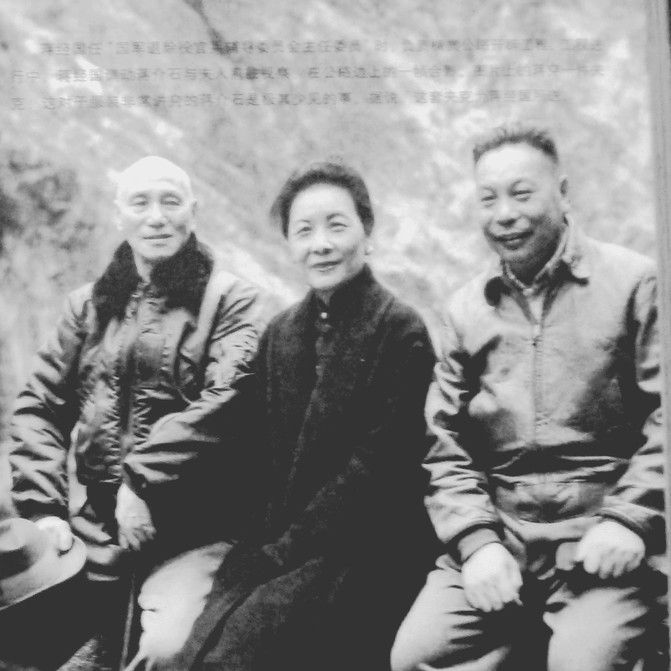
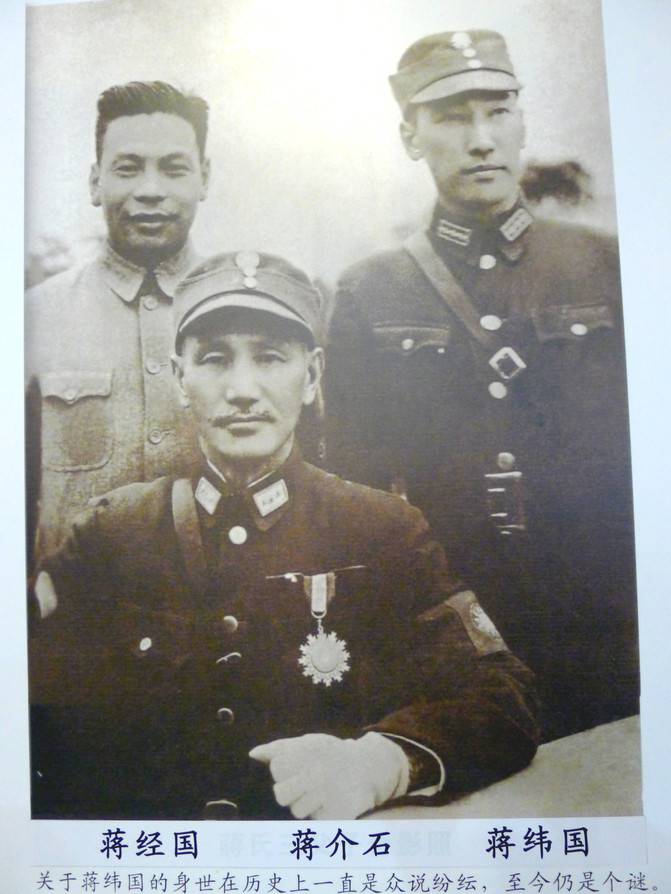
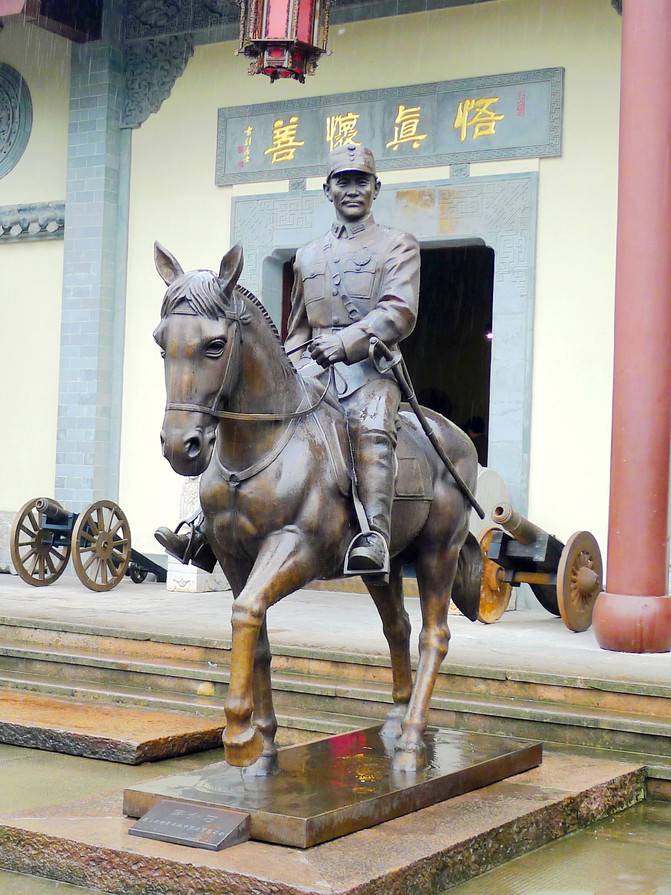
10: Walk out of the courtyard and cross the bridge to the opposite bank of "Shanxi". In the early years, it was once the "three mile long street" of Xikou ancient town, but now it has been transformed into a tourist pedestrian street, known as "Wuling road". "FengHao house", "Jiang's ancestral hall" and "small foreign house" are all scenic spots of "Jiang's former residence" series. We walked in the street in the rain, only standing outside the doors of the scenic spots to peep inside, not inside. On the one hand, all scenic spots need to buy tickets. On the other hand, the "driver" of the tricycle he took just now introduced that the real "former residence of Chiang Kai Shek" had been completely destroyed during the cultural revolution. Nowadays, only the location of these "former residences" is real, and others are fake. Moreover, all the "former residence" buildings have only shell, and the inside is empty. He also said that the "former residence of the Jiang family" that visitors see today, including this tourist pedestrian street, were all rebuilt with 40 million yuan after the third generation of the Jiang family (Jiang Xiaoyan) returned home to worship their ancestors.
Walk along the "three mile long street" and walk out of the "Wuling gate" at 10:57. This two-story gate style building is considered to be the gate of Xikou ancient town. It was funded by Chiang Kai Shek in 1930“ Wulingmen is only about 500 meters away from Huijin hotel where we stayed. The three people directly return to the hotel to check out, then drive on the road and look for a place to eat along the street. In recent days, the meals were more casual. X.J. suggested having a big lunch, so he chose a nearby "minzhen restaurant" which seems to be quite large. The restaurant has hosted many family dinners for "Jiang Gong" in history, and now it is also the designated dining place for the tourism team, with many buses in front of the door. 10. J. according to the service girl's introduction, we ordered wine lees, stewed pig's feet, fried vegetables, clam soup and rice, totaling 190 yuan. The feeling on the tip of the tongue was only average.
After dinner, go to Xuedou mountain, 8 kilometers northwest of Xikou town. The ancients called the spring Ruquan, the Dou Xuedou and the mountain Xuedou mountain because there was a Dou (cave) at the top of the mountain and the spring gushed out from it, splashing like snow and white as milk. Xuedou mountain scenic spot is a national key scenic spot with beautiful mountains, magnificent ravines, gorgeous waterfalls and deep forest springs. The main scenic spots are Xuedou temple, qianzhangyan, miaogaotai, sanyitan, etc.
We drove westward along Gongyuan North Road, passed by "Jiang Mu's tomb road", and finally arrived at "Xuedou mountain tourist center", which is also the entrance of Xuedou mountain scenic spot. Foreign vehicles are not allowed to enter the scenic spot. Visitors must take the scenic spot bus when they go up the mountain. The ticket price is 30 yuan / person. The car is parked in the parking lot of the tourist center, and the charge is 10 yuan. Tickets for the scenic spot are 120 yuan per person, half price for 60-69 years old, and free for 70 years old with ID card. The three of us have one full, one half and one free ticket, and it costs 270 yuan to buy three more tickets.
Take the scenic spot bus up the mountain. The road is winding. Get off at Xuedou Temple transfer station. According to the instructions of the scenic spot staff, first go to "qianzhangyan" for sightseeing. Qianzhangyan is a cliff on Xuedou mountain, with a drop of nearly 200 meters, not far from Xuedou temple. The water of the milk spring gathers in front of the gate of Xuedou temple to form a pool, and then pours down along qianzhangyan, forming the famous "Xuedou waterfall" on Xuedou mountain, also known as qianzhangyan waterfall. The full name of this scenic spot is miaogaotai, qianzhangyan (yangzhiqiao) scenic spot. The entrance is the cliff top of qianzhangyan. When we show our tickets to enter, we immediately see "Jinjing pool" and "qingsuo bridge". The pool is a small pond, and the bridge is also a small bridge. The water flows down the cliff through the hillside in front of the pool, forming a spectacular waterfall. There is a viewing platform at the entrance of the waterfall. However, you can't really appreciate the spectacular of the waterfall when you are at the top of the waterfall. Looking down from the fence, you can see that there is a "Yangzhi bridge" beside the cliff at the foot of the mountain, which is the best place to watch the waterfall. Zeng Gong (one of the eight masters of the Tang and Song dynasties) of the Northern Song Dynasty also came here to watch the waterfall, leaving a poem saying: "the snowflakes are turning at the jade Qiu's drooping place, the thunder in the four seasons and the cold in the six months, and the hurdles are not poor. Please look up from under the rock.".
Continue to climb along the long stone steps, pass the Feixue Pavilion, Guanyun Pavilion and Ruquan Pavilion, and arrive at Miao peak at 13:45. At the top of the mountain, there is a natural stone terrace, called miaogaotai. The East, West and south sides of the terrace soar into the sky, and the bottom is a precipice abyss. The north side is relatively wide, with a villa. This villa was originally built by Chiang Kai Shek when he first went out to live in seclusion in Xikou in 1927. On the lintel of the villa, there was the word "miaogaotai" inscribed by Chiang himself. Since then, whenever Chiang Kai Shek returned to his hometown, he would choose to live here. After retiring from the "President of the Republic of China" in January 1949, he set up a backstage headquarters here to control and confront the PLA crossing the Yangtze River“ There is a natural rock in the middle of "miaogaotai" Shiping, which is called "Yan Zuoshi". It is said that before "Jiang Gong" fled the mainland that year, he used to sit beside the stone and meditate. I also sat on the stone for a moment, thinking that Chiang Kai Shek could resist the Japanese aggressors for eight years. Why did he get into trouble with the Communist Party again, but only three years later he left five million troops behind“ It's hard to know what happened to "Chiang Kai Shek" in those days. However, the diary of "Chiang Kai Shek" on the day he left Xikou on display in his villa may be a guess: "in the morning, I left my grandmother's tomb with my father, and then walked up to the top of feifeng mountain. I looked around, but the mountain was speechless. Although I didn't shed tears, I couldn't express my grief. I wanted to visit FengHao house again, but I couldn't bear it. I wanted to say goodbye to my parents in the countryside, and I couldn't bear it. After seeing them, I couldn't take them with me, which only increased my attachment. Finally leave without saying goodbye...... Besides, Xikou is the site of the ancestral tomb. Today, I'm leaving. I can't describe the pain in my heart.
"Jiangjia villa" covers an area of about 400 square meters, with a combination of Chinese and Western styles. A sun terrace is built on the top of the bungalows on both sides of the gate, followed by a patio. Three 2-story buildings are built on the front of the patio, and a corridor is connected with the sun terrace on the second floor of the building. The villa is surrounded by green trees, with green mountains and clear water in the distance. However, the villa in front of us was not built by Chiang Kai Shek. The original house of the Chiang family was completely demolished as early as the cultural revolution. The existing building was rebuilt in 1986. During the reconstruction, a stone pagoda originally placed at the entrance of the main entrance was moved to the center of the patio. This pagoda was the futu of the abbot monk of Xuedou temple in the late Qing Dynasty and the early Republic of China. Because Chiang Kai Shek respected him very much, he moved the pagoda here during the construction of the villa. There is a cable car near the villa, which reaches to the bottom of qianzhangyan waterfall. It was built in recent years and has nothing to do with Chiang Kai Shek.
14: 15 leave miaogaotai, the original road retrograde downhill. About half an hour later, walk out of qianzhangyan scenic spot, and then cross a mountain road, which is the big Buddha Scenic Spot on Xuedou mountain“ "Great Buddha Scenic Spot" is actually Xuedou temple, because today's Buddhist circles believe that Xuedou mountain is Maitreya Bodhisattva dojo. Fenghua City takes the opportunity to build a tourism brand of "Maitreya culture", with a large investment of nearly 500 million, to build a Maitreya Great Buddha cultural park beside Xuedou temple. Therefore, Xuedou temple and its surrounding areas are collectively referred to as "Great Buddha Scenic Spot" in Fenghua City. This is because Xuedou mountain is the main peak of Siming Mountain in eastern Zhejiang. There is a guide map beside the door. It can be seen from the map that the Giant Buddha Scenic Area is obviously divided into two areas: the left side is the original Xuedou temple, and the right side is the Maitreya Giant Buddha Cultural Park newly built in recent years.
The Buddhist temple on Xuedou mountain first appeared in the Tang Dynasty. In the Song Dynasty, it became one of the "five mountains and ten temples" in China. The emperor granted the plaque of "Zisheng temple in Xuedou". As time goes by, the temples on Xuedou mountain have been revived and abandoned. However, until the 1960s, there are still some temples built in the early Qing Dynasty, such as Shanmen, Tianwang hall, Daxiong hall, Fatang, cangjing Pavilion, houdian, dongxixiang building and Abbot building. The people's government also allocated funds for maintenance twice in 1953 and 1962. However, similar to the fate of many ancient temples on Putuo Mountain seen yesterday, Xuedou temple also failed to avoid the disaster of "Cultural Revolution". In 1968, all the ancient buildings of the Qing Dynasty in Xuedou temple were demolished except seven East Chamber rooms. The existing Xuedou temple was rebuilt in the 1980s and 1990s. It looks magnificent, but it is only a modern antique building. Mahayana Buddhism believes that everyone can become a Buddha as long as he experiences many disasters. However, even after they became Buddhists, Guanyin and Maitreya could not escape the disaster of the "Cultural Revolution". They were both "swept out" in their hometown. Fortunately, Chairman Hua Guofeng smashed the gang of four, Guanyin and Maitreya returned home, and Deng Xiaoping's reform and opening up gave Bodhisattvas a bright future.
As for the Maitreya Cultural Park on the right side of the scenic spot, its history is more short. In 2005, the project of "Maitreya Buddha in the open air" was approved by the relevant departments of the state. The project was completed in 2008. A grand Kaiguang ceremony was held on November 8, and the Fenghua Municipal People's government also held the "2008 China (Fenghua) Xuedou mountain Maitreya Culture Festival" at the same time. Since then, the open-air Buddha on Xuedou mountain has become a landmark tourist attraction in Fenghua City“ Maitreya, also known as Maitreya Bodhisattva mahasa, is a common "three Buddha" statue in ancient grottoes. It stands side by side with "Sakyamuni Buddha" (in charge of the present world) and "burning lamp Buddha" (in charge of the past), and is responsible for the future Buddha. Tibetan Buddhism is called "Qiangba Buddha". It is said that when Sakyamuni started Buddhism, "Maitreya" was his disciple. This man was born into a Brahman family in ancient India's Baltic state, with his surname "Maitreya" and his name "ayido". Later, he went to extinction before Sakyamuni, and was declared by Sakyamuni that he had risen to the heavenly palace to discuss Dharma with the gods. After 5.674 billion years, he would reappear in the human world, succeeding Sakyamuni as the Buddha in charge of the future. However, the early Maitreya in ancient China was not the big belly monk in front of us. It is the Maitreya Buddha who wears the crown of heaven and sits on his feet for the Buddha who was introduced from India, which shows that Maitreya was still in the period of Tiangong discussing Dharma before becoming a Buddha, or it is the sitting Buddha created in Sui and Tang Dynasties in China, which shows that Maitreya after becoming a Buddha is just like Leshan Buddha in Sichuan.
One of the signs of the integration of Indian Buddhism and Chinese civilization and the gradual localization is to replace the original "Tianguan Maitreya" with the local monk "Budao monk". Budao monk was a monk in Fenghua at the end of Tang Dynasty, Five Dynasties and the beginning of Ten Kingdoms. His original name was Qizhi, and he was called changtingzi. Because he often used a Budao to fight with lotus, he was called Budao monk“ Qi "is fat and lives in a place of impermanence. It can show good or bad luck, and can know the weather. Before his death, he hinted that he was reincarnated as Maitreya, so he was praised as" Dadu Maitreya "after his death. In the third year of Chongning in the Northern Song Dynasty, the Yuelin temple in Fenghua first worshipped the Budai monk as Maitreya. Later, Buddhist temples in the Han Dynasty also changed the statue of "Tianguan Maitreya" from India, that is, the so-called real Maitreya statue, into the statue of Budai Maitreya with Chinese characteristics. It is because of this origin that Xuedou mountain in Fenghua City is naturally respected as "Maitreya Bodhisattva's Taoist center".
14: When you walk to the gate of the Grand Buddha Cultural Park, one shock after another will follow. On the screen wall next to the ticket gate, there is a large character "Maitreya Taoist temple". Beyond the wall, you can see the huge bronze statue of Maitreya Buddha from a distance. The main hall in the cultural park is called "Da CI mani hall". It is a hall dedicated to Maitreya Bodhisattva. When you stand in front of the hall and take photos, you don't have much feeling, but after you enter the hall, you immediately experience the unspeakable shock. The main hall is extremely tall, and it is not a reinforced concrete building. The internal support is made of thick wooden columns. It is estimated that the materials used are the whole tree that has been several hundred years old. China has stopped cutting down natural forests. Such huge timber should be imported from abroad. However, it is a pity that there are generally fine longitudinal cracks on the surface of the pillars. It is estimated that the reason is that the wood has not been fully dried before use due to the rush period.
The biggest shock occurred after we passed through the "Da CI mani hall". Just as we stepped out of the back door of the hall, we immediately saw a huge golden Buddha on the top of the mountain. Drizzle, fog all over the mountain, the peak of the "Maitreya" is like sitting in the clouds. The Buddha is 33 meters tall (meaning Maitreya lives for "thirty-three days"), sitting on a 9-meter-high lotus throne with a three-story circular platform modeled after the temple of heaven in Beijing. The building is 56.74 meters high, implying that Maitreya will come to earth in 5674 million years to replace Sakyamuni as Buddha. A total of more than 500 tons of tin bronze were used to cast the Great Buddha. There are more than 1000 tons of steel frames inside the statue, connecting the statue with the whole rock.
LP looked at the high stone steps and was unwilling to move on, so she had to stay alone in the "Da CI mani Palace" to have a rest. X.J. and I climbed the mountain together. First, walk through the three-story stone steps and come to the broad "Longhua square". The tall "CHIGUO", "growth", "Guangmu" and "Duowen" Heavenly Kings sit in the four corners of the square. In ordinary Buddhist temples, the four heavenly kings often accompany "Dadu Maitreya" to stay in "Tianwang hall". Now Maitreya has a luxurious residence, and of course, the four heavenly kings have to come to support. On the wall at the end of the square, there are four big characters "Hualong Qihui", whose meaning is still unclear.
Continue climbing, and the stone steps lead to the "Buddha platform" on the next level. The central part of this section of stone steps is inlaid with large white marble reliefs. The contents are all kinds of Buddhist stories. The carving is extremely exquisite and delicate“ There is a huge incense burner on the platform, but the incense fire is not vigorous, far less than the grand occasion of Nanhai Guanyin Buddha in Putuo Mountain.
Then move forward, climb to the foot of the huge Buddha statue along the "future Avenue" with blooming flowers, and hang the plaque of "Maitreya on earth" here, highlighting that the "Maitreya" in front of you is the image of "cloth bag monk" who has been integrated into the world. Maitreya Buddha is a monk and a arhat. He is always smiling. He carries a cloth bag in his left hand and holds a Buddha's bead in his right hand. His face is plump, his ears are drooping, his breast is bared, and his belly is round. It makes people feel both cordial and solemn. Climbing to the highest place, you can have a panoramic view of the whole Buddha Scenic Area. The building community with a yellow roof on the right side is the current Xuedou temple.
15: 54 go down the mountain, join LP at the "Daci mani Palace", and then enter Xuedou temple again. Xuedou mountain, as Maitreya Bodhisattva's ashram, is not as well recognized as Putuo, Wutai, Emei and Jiuhua as Guanyin, Manjusri, Puxian and dizang Bodhisattva's ashram. When I visited Guizhou in 2010, the local people claimed that Fanjing Mountain was the real Maitreya Bodhisattva Taoist center. Moreover, it was only about 80 years ago that Xuedou mountain was first known as Maitreya Taoist center. The abbot of Xuedou temple first proposed that Xuedou mountain should be listed as the fifth famous mountain of Buddhism in China and recognized as Maitreya Bodhisattva Taoist center. This view was strongly supported by Zhao Puchu, President of the National Buddhist Association. In 1987, Xuedou temple was rebuilt. Zhao specially proposed to build a "Maitreya hall" which is not found in other temples, so as to highlight the status of Xuedou mountain as Maitreya Bodhisattva's Taoist center. The main Buddha worshipped in Maitreya hall is Maitreya with cloth bags, and thousands of statues of little Maitreya are created on both sides, which is also the first in Buddhist temples at home and abroad. Moreover, this Maitreya hall is also the only one with yellow glazed tiles in the whole Buddha Scenic Area.
16: When you walk out of Xuedou temple on the 20th, there is also a place where Chiang Kai Shek imprisoned Zhang Xueliang. I hope you can go and have a look. However, X.J. stressed that he had to go to Haining next. In order to reduce the driving time at night as much as possible, it's better to hurry down the mountain now. I support my son's opinion. So the three took the scenic spot bus down the mountain, changed to our own car in the parking lot, returned to Xikou town to refuel for 100 yuan, got on the highway at "Xikou East toll station", and drove straight to Yanguan town in Haining county. Tomorrow is the first day of October, just in time to catch up with the spring tide of Qiantang River.
We still drive according to the electronic map and voice prompts on the mobile phone. Soon it will be dark. What's more, X.J. is sleepy. Sometimes he even feels that he has closed his eyes instantly, so he has to stop temporarily in the emergency lane of the expressway and open the double flash film. Only later did we know that we had violated the traffic regulations, but fortunately we were not found by the police. After going on the road, I saw the "Yuyao service area". I drove into the fast-food restaurant attached to the service area to have dinner: cold cabbage, scrambled eggs with tomatoes, sauteed cabbage, steamed egg soup, rice, and three tomato egg laver soup. The total cost of the three was 54 yuan. There is also "Starbucks" in the service area, which bought a small latte to refresh X.J. for 20 yuan, and then refuelled the car for 100 yuan.
10. J. after a cup of coffee, he continued to drive and was in a good mood. After that, he got off the expressway at Yanguan toll station in Haining county at 19:46 and paid 90 yuan“ "Mobile guide" has been guiding us to the door of the "tide watching Hotel" that we have reserved in advance, and then using voice to prompt "we have arrived at the end of this trip"“ The "tide View Hotel" is located beside the road outside the ancient town of Yanguan. We asked for a three bed room, which is quite small and simple, 160 yuan / day. We complain that the house price is too expensive, but the landlady said that we would like to choose such a day to watch the tide. If we catch up with the "tide Festival" in September, we can also watch the tide. For a room like this, at least 600 yuan is not available.
Leave a Comment